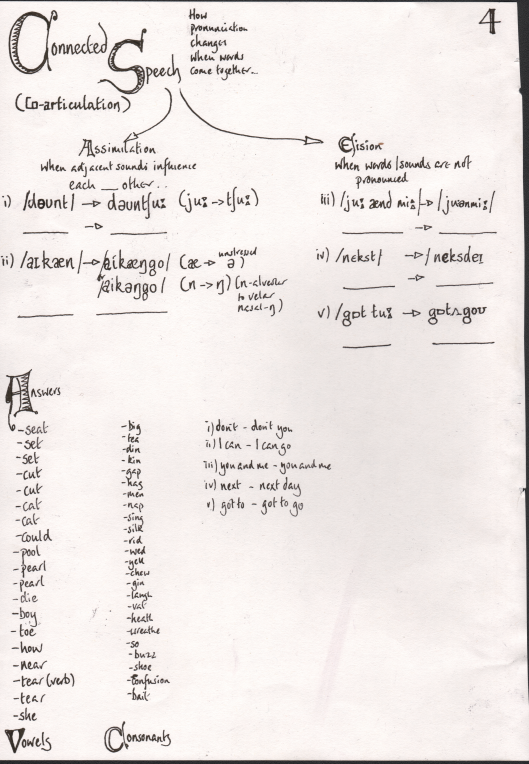Posted by willteach | Filed under Uncategorized
Phonetics worksheet on Prosody
05 Monday Jun 2017
05 Monday Jun 2017
04 Sunday Jun 2017
Posted in Uncategorized
What happens when phonemes meet (and answers for p3)
03 Saturday Jun 2017
01 Thursday Jun 2017
01 Thursday Jun 2017
31 Wednesday May 2017
10 Sunday Jul 2016
Posted in Uncategorized
Planning for next year and trying to fit things into a framework led me to Laurie Smith’s paper on ‘Life after Levels’.
‘…Students will need regular formative and summative assessments during Years 7 to 11. These will be most effective if they are carried out on the same basis throughout the five years and relate directly to the assessment objectives for the new GCSE examinations.’…
2 per half term, one Lit, one Lang, based on a question from the GCSE papers + lots of cognitive acceleration (his LetsThink programme at KCL). Relieved to find someone so reasonably critical of APP/Levels so I’ll be exploring it by starting with Adey’s Really Raising Standards.
03 Tuesday Jun 2014
Posted in Uncategorized
So the choice of 19th C novel for GCSE English Lit in England and Wales from 2015 is Great Expectations, Christmas Carol, Sign of Four, Silas Marner, Jane Eyre, Jekyll and Hyde and Pride and Prejudice and War of the Worlds. Which to teach? Let’s size up the choices first: 544pp(GE), 385(JE), 373(P+P), 192(SM), 138(Sof4), 91pp(J+H), 86(CC), 303(WofW). The pre-2015 choice which caused all the row this week, was between: To Kill a Mockingbird (384pp), Purple Hibiscus (250), Mr Pip (256), Rabbit Proof Fence (136), and Of Mice and Men(106). If Mr Gove is right that 80% of students studied Steinbeck’s novel, perhaps he will end up with the same issue in the new curriculum, with schools concentrating their efforts on the shorter novels? My Head of Department said we didn’t do Adichie because she wasn’t confident the examiners would know the text! Of course the solution is author lists as in the International Baccalaureate Diploma programme. Oh but that’s not realistic because it’s a bit international and that’s not the direction of travel now there’s no more Nigerian, Australian, Papua New Guinean novels anyway . After all KS4 is to prepare pupils for life after school in the British Isles, and their ‘principal focus’ should be English Literature, through which they will appreciate the ‘power’ of the English literary heritage. Yuck.
01 Monday Jul 2013
Posted in Poetry
Heroism was normal?- Wilfred Owen was killed during an attack across the Ors canal. The attack was turning into a disaster, until James Kirk intervened. The Official War record states –
The attempt by 2nd Manchesters and 16th Lancashire Fusiliers to cross the canal, north of Ors, was unsuccessful. 218th Field Company, Royal Engineers, threw two bridges, but the southern one was smashed after two platoons had crossed, machine gun fire prevented the use of the other and over two hundred casualties were suffered.
Kirk’s citation for a VC describes how he saved the attack,
‘…To cover the bridging of the canal he took a Lewis gun and, under intense machine gun fire, paddled across the canal on a raft and, at a range of ten yards, expended all his ammunition. Further ammunition was paddled across to him and he continuously maintained a covering fire for the bridging party from a most exposed position till killed at his gun. The supreme contempt of danger and magnificent self-sacrifice displayed by this gallant officer prevented many casualties and enabled two platoons to cross the bridge before it was destroyed.”
http://www.stockport1914-1918.co.uk/soldier.php?name_id=1521
08 Monday Apr 2013
Posted in Books
‘And that’s when I saw him. The blind man. Raincoat, hat, dark glasses, white stick. He was standing at the back of a dark-coloured van. A Transit, I think. The back doors were open and there was a heavy looking suitcase on the ground…’
And so Kevin Brooks’ latest protagonist, Linus, is captivated, entranced, caught and entombed. And so are we, locked into the claustrophobic imaginative creation of ‘The Bunker Diary’. It’s a cracker that works at multiple levels…right at the frontline of the battle for reading that is YA fiction.